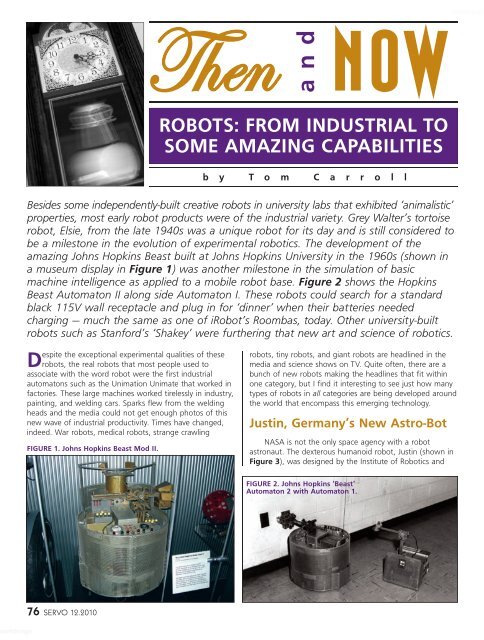Create successful ePaper yourself
Turn your PDF publications into a flip-book with our unique Google optimized e-Paper software.
worldmags<br />
Despite the exceptional experimental qualities of these<br />
robots, the real robots that most people used to<br />
associate with the word robot were the first industrial<br />
automatons such as the Unimation Unimate that worked in<br />
factories. These large machines worked tirelessly in industry,<br />
painting, <strong>and</strong> welding cars. Sparks flew from the welding<br />
heads <strong>and</strong> the media could not get enough photos of this<br />
new wave of industrial productivity. Times have changed,<br />
indeed. War robots, medical robots, strange crawling<br />
76 SERVO 12.2010<br />
worldmags<br />
Then NOW<br />
<strong>and</strong><br />
<strong>ROBOTS</strong>: FROM INDUSTRIAL TO<br />
SOME AMAZING CAPABILITIES<br />
b y T o m C a r r o l l<br />
Besides some independently-built creative robots in university labs that exhibited ‘animalistic’<br />
properties, most early robot products were of the industrial variety. Grey Walter’s tortoise<br />
robot, Elsie, from the late 1940s was a unique robot for its day <strong>and</strong> is still considered to<br />
be a milestone in the evolution of experimental robotics. The development of the<br />
amazing Johns Hopkins Beast built at Johns Hopkins University in the 1960s (shown in<br />
a museum display in Figure 1) was another milestone in the simulation of basic<br />
machine intelligence as applied to a mobile robot base. Figure 2 shows the Hopkins<br />
Beast Automaton II along side Automaton I. These robots could search for a st<strong>and</strong>ard<br />
black 115V wall receptacle <strong>and</strong> plug in for ‘dinner’ when their batteries needed<br />
charging — much the same as one of iRobot’s Roombas, today. Other university-built<br />
robots such as Stanford’s ‘Shakey’ were furthering that new art <strong>and</strong> science of robotics.<br />
FIGURE 1. Johns Hopkins Beast Mod II.<br />
robots, tiny robots, <strong>and</strong> giant robots are headlined in the<br />
media <strong>and</strong> science shows on TV. Quite often, there are a<br />
bunch of new robots making the headlines that fit within<br />
one category, but I find it interesting to see just how many<br />
types of robots in all categories are being developed around<br />
the world that encompass this emerging technology.<br />
Justin, Germany’s New Astro-Bot<br />
NASA is not the only space agency with a robot<br />
astronaut. The dexterous humanoid robot, Justin (shown in<br />
Figure 3), was designed by the Institute of Robotics <strong>and</strong><br />
FIGURE 2. Johns Hopkins ‘Beast’<br />
Automaton 2 with Automaton 1.




